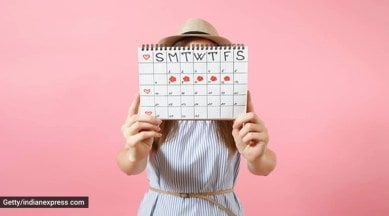📣 For more lifestyle news, click here to join our WhatsApp Channel and also follow us on Instagram
A menstrual guide to understanding your period better
The number of days in your menstrual cycle varies from menarche -- when periods begin during adolescence -- until menopause (when your periods stop forever), said Dr Pratima Thamke, consultant obstetrician and gynaecologist, Motherhood Hospital, Kharghar.

A regular menstrual cycle lasts anywhere between 21 to 35 days, with women experiencing different symptoms (or none at all) depending on their period flow and other underlying conditions. But, it must be understood that “your menstrual cycle is much more than bleeding and bleeding-free days,” wrote Anushka, a certified holistic nutritionist, on Instagram. She added that it is also a “synchronous play of hormones” that can cause major mood swings every month. As such, understanding your menstrual cycle and how it affects the body can prove to be extremely beneficial — for which, she shared a guide. Take a look at it below.
“Your menstrual cycle is much more than bleeding and bleeding-free days. The synchronous play of hormones takes us through a roller coaster ride every month. Wouldn’t it be nice if we understood our cycle and supported our bodies? This guide is designed to help you understand your menstrual cycle. This information is based on a 28-day cycle, but it varies from woman to woman. Use some type of tracking system to understand your cycle,” she captioned her Instagram post.
Her post is a comprehensive map that explains how the menstrual cycle — which is divided into four phases: menstrual, follicular, ovulatory, and luteal — works.
Menstrual phase: Day 1-7
This cycle begins on the first day of your periods. It is known as the inner winter season. The hormones oestrogen and progesterone drop, which can cause intense exhaustion. Low energy levels make you want to rest and sleep more. Great time to evaluate, strategise, and review your goals.
Follicular phase: Day 8-13
This cycle starts as soon as the menstrua period ends. It is known as the inner spring season. Oestrogen starts peaking, just before ovulation but progesterone remains low. With more energy and brain power, it’s the perfect time for starting something new. Metabolism slows and one is more insulin sensitive.
Ovulatory phase: Day 14-21
The body releases an egg into the fallopian tubes and down into the uterus. It is known as the inner summer season. Oestrogen and luteinizing hormone (LH) both peak to stimulate the release of an egg. Fertility peaks just before you ovulate. The sex drive peaks this time. Overall energy and motivation is high, and you feel confident and attractive.
Luteal phase: Day 22-28
This phase begins after ovulation. It’s the inner fall. Progesterone rises, priming the uterus for the arrival of a fertilized embryo. If you’re not pregnant, oestrogen and progesterone drop and the womb lining sheds, causing your period. As progesterone increases you might find your energy winding down. You may have mood swings, anxiety or irritability and cravings for comfort food.
The number of days in your menstrual cycle varies from menarche — when periods begin during adolescence — until menopause (when your periods stop forever), explained Dr Pratima Thamke, consultant obstetrician and gynaecologist, Motherhood Hospital, Kharghar, adding that keeping track of one’s menstrual cycle has several benefits.
For instance, if you are aware of the cyclical symptoms’ root causes, you will be better able to comprehend and treat them. “Depending on what stage of your cycle you are in, you may have varied sexual experiences, feel bloated, have migraines, break out in acne, have digestive issues, etc. In fact, many women have noted that their mental health is also impacted by their menstrual cycle,” Dr Thamke told indianexpress.com.
To help you anticipate and prepare for your next periods, you can record the dates of your periods someplace. “With technological improvements, tracking your menstrual cycle or periods has also gotten much simpler. Simply download a period tracking software to your smartphone to accomplish that,” she said.
How to calculate?
To calculate your menstrual cycle, start counting on the first day of your period and go all the way up to the day before your next period starts.
For instance, if your period began on January 1 and ended on January 5, you would begin counting your menstrual cycle on January 1 and do so until the start of your subsequent period. As a result, if your period starts on January 31 and your last period was on January 1, your menstrual cycle lasted for an average of 30 days, said Dr Thamke.
However, it’s crucial to keep in mind that pre-period spotting doesn’t constitute the start of your period. When you start bleeding often, your period officially starts, said Dr Thamke.
For more lifestyle news, follow us on Instagram | Twitter | Facebook and don’t miss out on the latest updates!
Also Read in Gujarati: Click Here
📣 For more lifestyle news, click here to join our WhatsApp Channel and also follow us on Instagram